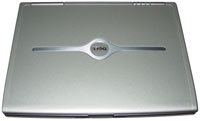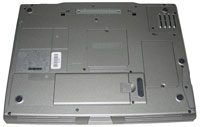Dell Inspiron 8600: Mobile Multimedia goes Wide Screen
by Andrew Ku on October 9, 2003 1:00 AM EST- Posted in
- Laptops
Construction — Build, Appearance, Size (continued)
The Inspiron 8600 follows the same basic design as the Latitude D800, which we covered in our Centrino roundup, but we will go over it nevertheless. The front of the Inspiron 8600 is practically bare, excluding a screen release mechanism (a simple push design, which is more user friendly than the slide release mechanisms) and two speaker ports. The left and right speakers are spaced about 3" inches from the center of the system, and is slightly angled down since the front of the system is sloped down. This helps prevent hands from creating a layout conflict with the speakers, and at the same time, it channels the sound to the surface, where the system lays.Click to enlarge.
Starting from the left, the side of the Inspiron 8600 reveals a hard drive bay, which can be removed via a single screw on the bottom of the system. Removing the hard drive bay involves removing the cutout, which also houses two audio ports, one for headphones and the other for microphone in. To the left of this is the unit's PCMCIA card slot, which houses a dummy card. Directly below this is where the D800's smart card reader would be, which is seen infrequently in other mobile systems (for the 8600, the gap is filled). Dell told us previously that this was due to direct customer feedback, and it provides “what you have” security into the pre-existing “what you know” security infrastructure.
Below the PCMCIA card slot and where the smart card reader would be is the system's IR window. Traditionally, we are used to having the IR window on the right side, but this didn't seem to cause any problems for us. If anything, it did make it easier to transfer files via IR between two mobile systems. To the left of this stack is the single 4-pin IEEE-1394 unpowered firewire port. We were previously informed by Dell that they plan to move away from the mini-IEEE-1394 port and replace it with a full-sized firewire port. We are still waiting to see what is going to be carried out.
At the furthest left is the unit's cooling vent. Cool air is drawn in from here and passes over the heatsink surface before exiting the system from the bottom.
Click to enlarge.
The large holes on the back right side of the system are hot air exhaust ports. Directly behind them lies the system's CPU heatsink. The next port (going from right to left) is the power port. Dell has wisely chosen to stay away from keyed power plugs in favor of a circular plug, which can be inserted in any direction. To the left of the power port is a recessed portion of the system, which is home to three ports: a serial port, a VGA-out port, and a parallel port. The recessed design helps keep the amount of cable protruding form the back at the minimum. The back of the system also is home to a modem jack, ethernet jack, two USB 2.0 ports, and a S-video out port, which are left to the recessed portion of the system.
Click to enlarge.
The Inspiron 8600 features one major difference from the Latitude D800, which is noticeable on the right side of the system. Where the D800 has a “D/Bay” connector and an USB 2.0 port, the 8600 has nothing. This portion of the system instead is covered up with nothing behind. To the left of this is the modular bay, which houses a DVD+RW drive (the default selection). So far, the system is only configurable with the CD-RW/DVD combo drive or a DVD+RW drive. The modular bay can also accept a floppy drive, a second battery, or a second hard drive. The devices are hot swappable via a release lever that is built into drive bay mechanism. However, according to Dell's configuration page for the 8600, a modular hard drive doesn't seem to be available.
Near the front of the system is home to a lock port on both the left and right side of the system. This gives more freedom for users to arrange their system's position in relation to where the system will be locked up.
Click to enlarge.
There are three access panels on the bottom of the 8600. The large panel in the center of the system is home to the system's two SODIMM slots. Our test system came configured with 512MB of memory, which populated only one slot. The smaller access panel to the right is home to the mini-PCI slot and the internal modem.
Dell has made wisely the choice to create a simple removable component out of the CPU fan. Only two screws hold the fan in place, which has been designed to be easy for the user to remove. The CPU fan is usually one of the first components to break and/or become noisy. Because Dell has fashioned a user accessible CPU fan, Dell has decreased the amount of support and overhead they need to provide users. Instead of a user sending in the entire system, Dell can now ship out a replacement fan for end-users, which the consumer can install. Additionally, the easy access reduces the amount of service that Dell needs to provide, since the user can perform the function themselves.
The long slot along the back of the system is the docking station connection. Dell's new docking solutions are of particular interest, since they offer DVI out connections and a monitor stand that allows the system to serve as a display with an external keyboard and mouse.
The 8600 fashions a typical Dell battery, which has a push button that provides the charge status of the battery via 5 LEDs. Each LED accounts for 20% of battery charge. This may seem like a small feature. But it will definitely come in handy, because a user no longer has to boot up to find out how much battery charge is left.
| Click to enlarge. |
Click to enlarge. |
As we stated for the D800, we have some mixed feeling about the 8600. The use of the Pentium-M processor and Centrino technology should have allowed Dell the freedom to create a more thin and lightweight notebook. However, the Inspiron 8600 is fairly large at 14.2" x 10.8" x 1.5", which keeps it out of the thin characterization. With a weight of about 7 pounds or greater, the 8600 is certainly not lightweight. Compared to other previous Dell systems, the 8600 is thinner, but there is some work to be done for it to measure up to other thin and light notebooks. This isn't denying the fact that the 8600 and the D800 are certainly powerful notebooks, but it would have been nice to see some of the advantages of Centrino technology, in terms of form, taken advantage of.
















21 Comments
View All Comments
olberd - Wednesday, December 15, 2004 - link
I've bought a Dell 8600c and I'm wondering if I can use generic SODIMM 200pin RAM for it, or I must use the more expensive RAM from kingston specifically designed for it.Some computer resellers tell me that I must use the kingston RAM 5150 for Dell. But a Dell supporter told me that standard RAM will do as well.
I understand that some notebooks are made with customized RAM modules. This makes spare parts more expensive and thus makes it an interesting note to add in the review of a notebook computer.
Rune
Duddy - Friday, November 26, 2004 - link
I just purchased an 8600 from Dell.com and the option for a Mobility Radeon 9600 was there and I ordered it. :)VIDEO: 128MB DDR ATI's MOBILITY® RADEON? 9600 PROTURBO
Total came out to be around $1800 plus 20% off all Inspiron notebooks. I paid exactly $1,516.40.
akodi - Thursday, November 6, 2003 - link
I bought a dell 8500 last week and am typing on it currently, it is the most awesome laptop I have ever used, the screen is super sharp (15.4 sxga+) to tell you the truth 1900x1200 would be way too small, 1680x1050 is preemo, so much damn realestate. I had a centrino but wasn't too impressed (600m) battery life was not that much better than a standard p4m, perhaps only a difference of a half hour. Being a college student at Cal I believe the 8500 is perfect, because at the library there are many power outlets so battery life isn't an issue, also if you plug in a wlan card you can use it in the library without a hitch (preemo bandwidth). On the video card issue, I wouldn't want to play games on a laptop not because of the graphics but mainly for the sound quality...sigmatel in my opinion is not kosher on the ears. Long live the forums and dell stackable coupons.Andrew Ku - Tuesday, October 28, 2003 - link
Sony, doesn't sell in the same volumes as Dell. Toshiba was the first to market with the Go56x0 (we mentioned this in the M10 and NV31M head to head). However, this was mainly with the Japanese market. This is also the case with Sony, as they are not widespread domestically. We didn't say that the 8600 was the first with NV31M; we said it was the first mainstream laptop with NV31M. This is in the context of the domestic market and demographics.Anonymous User - Saturday, October 18, 2003 - link
Just wanted to correct an error in the article. The Dell is not the first laptop with the Geforce FX 5600go. In fact I'm typing on a laptop that has one in it right now - a laptop I bought 3 months ago. The Sony Vaio GRT170. Just thought I'd let you know.Anonymous User - Thursday, October 16, 2003 - link
Somebody know EUROCOM notebooks?? are they good quality? They have "nice" notebooks wit m10pAnonymous User - Thursday, October 16, 2003 - link
nice photoshop art in my opinion... otherwise Andrew Ku would aahve known this don't you think????Anonymous User - Wednesday, October 15, 2003 - link
http://forum.tt-hardware.com/uploads/pub_dell_pcac...This scan shows a Dell 8600 with a mobility Radeon 9600XT (128mb). It does not show up on any of the dell sites I visited (French, Dutch, English). Is this a hoax or a dream come true?
Anonymous User - Wednesday, October 15, 2003 - link
Whatever... Dell is bull....Anonymous User - Sunday, October 12, 2003 - link
I must apollogize Mr Ku , I do seem to be wrong on certain facts there , but for my interest , would you kindly explain where the term Molex comes into mbile processing ,as it also refers to the electrical connector for a hard drive(or so I have been told/taught ) . As for Mobile processing often been entirely diffrent park , doesn't a desktop replacement laptop like , say a dell 8600 user a Pentuim-M chip , which uses 478 PPGA Flip - chip 2 array , just likes its desktop brother , the same that can be found in certain laptops as well , ? and doesn't Laptops use 333MHz DDR -Ram (albiet in SO-DIMM format ) , latest GPU'S , 7200 RPM hardrives , and some even with RAID systems . Please would you clarify this , as I am not challenging you , just simply asking ?Bandwidth Boy